Polychaetes
Polychaetes are segmented marine worms. They are one of the most abundant and species rich groups of organisms found in marine sediments. Polychaetes are commonly known as bristle worms due to their hair like appendages known as ‘chaete’ or ‘setae’. They are a highly diverse group of organisms in both their appearance and their ways of life. This diversity relates to their evolutionary history, of which there are long fossils records dating back to the mid Cambrian (>500 million years ago). Some species form tube like structures or burrows in which they live, whilst other species are free living. Some filter feed from the water column, others scavenge or actively hunt prey within the sediment.
As polychaete densities can reach several thousand per square metre they are an important food source for organisms such as fish and wading birds. There are more than 14,000 polychaete species worldwide of which at least 776 species are found in New Zealand (246 are endemic). Certain species are known to respond to changes in fine terrestrial sediment (mud), pollution and organic enrichment in a predictable way, making them good indicators of estuarine health. A large number of different polychaete species have been recorded in Waikato estuaries. The most common polychaete species we monitor are shown below.
-
Due to their great morphological diversity, polychaete worms can be hard to recognise to the untrained eye. One of the most apparent features of polychaete worms are the paired paddle like lobed appendages on either side of their body segments known collectively as parapodia. Each parapod is used for locomotion and has a number of bristles or ‘setae’ (also called chaetae) protruding from it. In tube dwelling polychaetes, these features are reduced as they are less mobile. Setae run the length of the body and act to grip, maintain position or aid locomotion depending on the species of worm.
Typically, polychaetes have a well developed head (prostomium) which has 2 to 4 pairs of eyes that sense light and dark, a pair of sensory antennae, a pair of tentacle like feelers (palps) and a mouth. The form of the mouth depends greatly on the diet of the species since this group of worms includes predators, herbivores, filter feeders, scavengers, and parasites. Most free living polychaetes possess a pair of internal jaws that can be quickly pushed outward to grab at food. Filter feeding species have sensitive ciliated tentacles that capture food in the water column. Often just behind the head are a set of external gills that have a feathery appearance, however some species breathe directly through the body wall so do not have these structures. The peristomium is the name given to the first body segment directly behind the head.
Life cycle
Reproduction in polychaetes can be either sexual or asexual. Asexual reproduction occurs through fragmentation or budding. In sexual reproduction, fertilised eggs hatch in to larvae which grow in the water column for a period of time prior to settling on the sea floor.
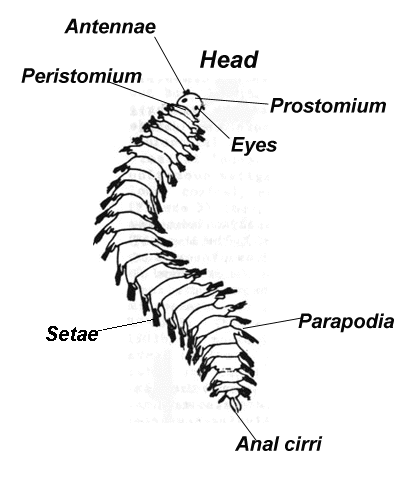
Generalised polychaete anatomy (Source: National University of Singapore, http://rmbr.nus.edu.sg/polychaete/feet.html)
Descriptions of species commonly found in Waikato estuaries
-
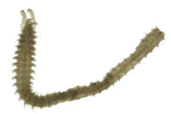
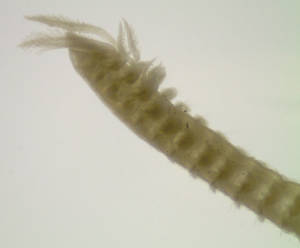
Close view of Prionospio aucklandica head region
Latin name: Prionospio aucklandica
Scientific group or class: Polychaete
Description: Prionospio aucklandica is a spionid worm, which is slightly larger than the related spionid species Aonides trifida. Prionospio aucklandica has two pairs of eyes with a rounded head, and three pairs of feather-like gills. It is a surface deposit-feeder.
Habitat: Prefers living in muddy sands and is common in the lower intertidal regions of estuaries and harbours, living within the sediment and burrowing to a depth of about 10cm.
Distribution: New Zealand wide
Indicator species: Yes
Why is this a good indicator species? Prionospio aucklandica tolerates a sediment mud content of up to 95%, with an optimum range of 20-70%. It is usually found in moderately to very muddy habitats, but is less abundant in extremely muddy areas (>70% mud). Prionospio aucklandica is also sensitive to copper contamination. Where estuarine sediments change from a sandy to muddier type habitat, the abundance of Prionospio aucklandica is expected to increase. However, where the sediment mud content exceeds its optimum range (>70%) or becomes more polluted (particularly with copper), the abundance of Prionospio aucklandica is likely to decline. This makes Prionospio aucklandica a good indicator species with which to assess changes in the input of sediment and pollutants into our estuaries.
-

Latin name: Goniadidae (goniadids)
Scientific group or class: Polychaete
Description: Goniadids are highly mobile, burrowing predators, scavengers and bioturbators. Goniadids are probably predators of other small polychaetes and themselves are prey for fish and birds. They can grow up to 260mm in length (although usually less than 50mm). Goniadids are often smaller and more slender than Glycera spp. They have an eversible proboscis with one pair of large chitinous jaws (compared to four found in Glycera spp.).
Habitat: Soft sediments – intertidal, subtidal and offshore (continental shelf)
Distribution: New Zealand wide
Indicator species: Yes
Why is this a good indicator species? Goniadids tolerate a sediment mud content up to 60%, with an optimum range of 50-55%. Therefore, they are usually found in more muddy habitats with some sand. Goniadids have also shown sensitivity to copper contamination.
Where estuarine sediments change from a sandy to muddier type habitat the abundance ofgoniadids is expected to increase. However, where sediment mud content exceeds their optimum range (50-55%) or sediments become polluted (particularly with copper), goniadids are expected to decrease in abundance. This response to change in the physical and chemical environment makesgoniadids good indicators with which to assess changes in the input of sediment and pollutants into our estuaries.
-
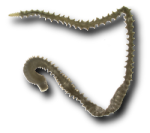
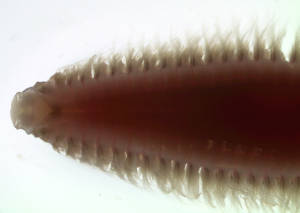
Aglaophamus spp. head region stained pink with rose bengal
Latin name: Aglaophamus spp.
Scientific group or class: Polychaete
Description: Aglaophamus spp. are large (up to 170mm in length) muscular, vigorous, free-burrowing nephtyid worms. They are usually white or cream in colour. Nephtyids are important secondary predators in sediment-dwelling organism communities and a food source for birds and fish. There are two common species found in New Zealand, Aglaophamus macroura and Aglaophamus verrilli. We currently list both species combined as Aglaophamus spp.
Habitat: Aglaophamus macroura is mainly found on the intertidal sand flats in harbours, whereas Aglaophamus verrilli is found in the subtidal region in fine to muddy sands.
Distribution: New Zealand wide
Indicator species: Yes
Why is this a good indicator species? At present little is known about the biology of Aglaophamus spp. or their sensitivity to sediment mud content. However, they generally prefer sandy habitats over muddy ones. Accordingly, increases in sediment mud content are likely to result in a decline in Aglaophamus spp. abundance.
-
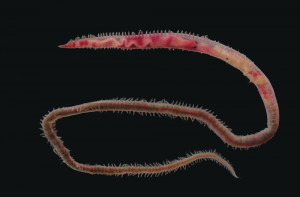
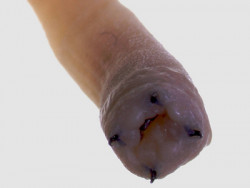
Common name: Blood worms
Latin name: Glycera spp. (glycerids)
Scientific group or class: Polychaete
Description: The glycerids are large, very muscular, active, burrowing ambush predators and scavengers/bioturbators. Adults can grow up to 350-400mm long and 15mm in diameter. They have a long muscular foregut region called a pharynx, which includes a proboscis. There are four large chitinous jaws at the tip of the proboscis which are made of tough semitransparent chitin (compared to Goniada spp. which have two jaws). The whole pharynx can be expelled (everted) forcefully through the mouth to grasp or capture prey (and also to burrow). At the base of the jaws are poison glands filled with a neurotoxin used to kill prey. A bite from a large glycerid, although not lethal, can be painful even to humans. Some species of bloodworm are extensively harvested along the northeastern coast of the United States for use as bait in fishing. They are also used for bait in South Australia.
Habitat: Prefer sands and sandy mud habitats from intertidal to the deep sea
Distribution: New Zealand wide
Indicator species: Yes
Why is this a good indicator species? Glycerids tolerate a sediment mud content up to 95%, with an optimum range of 10-15%. Therefore, they are usually most abundant in sandy habitats with some mud content. Glycerids are sensitive to low levels oxygen, which can occur in organically enriched estuarine sediments. Where estuarine sediments become muddier (exceeding their optimum range) and/or organically enriched, the abundance of glycerids is likely to decline. This makes glycerids a good indicator species with which to assess changes in the input of sediment and nutrients into our estuaries.
-
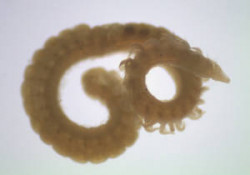
Latin name: Aonides trifida
Scientific group or class: Polychaete
Description: Aonides trifida is a small thin active spionid worm (smaller than a related spionid species, Prionospio aucklandica), with a pointed head and two pairs of eyes. It is a surface deposit feeder and bioturbator and a prey for fish and birds. Aonides trifida grows up to 100mm in length.
Habitat: Prefers living in fine sands (low mud content) to 10cm sediment depth.
Distribution: New Zealand wide
Indicator species: Yes
Why is this a good indicator species? Aonides trifida tolerates a sediment mud content up to 80%, but has an optimum range of 0-5%. Accordingly, Aonides trifida is most abundant in sandy habitats. Aonides trifida is also sensitive to copper contamination. Where the sediment becomes muddier (exceeding its optimum range) and/or polluted (particularly with copper), the abundance of Aonides trifida is likely to decline. This makes Aonides trifida a good indicator species with which to assess changes in the input of sediment and pollutants into our estuaries.
-
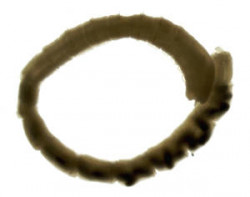
Latin name: Capitellidae
Scientific group or class: Polychaete
Description: Capitellid worms are long, thin and fragile worms. They have no head appendages or other distinguishable characteristics. Adults can grow up to 50mm long. Capitellids are subsurface deposit feeders and bioturbators. They are prey for fish and birds.
Habitat: Capitellids prefer a muddy sand habitat in estuaries and harbours where they can burrow deeply into the sediment (to about 10cm). They sometimes flourish in organically-enriched environments and are one of the few worms which can be found in very high numbers around organic effluent discharges.
Distribution: New Zealand wide
Indicator species: Yes
Why is this a good indicator species? Capitellids tolerate a sediment mud content of up to 95%, with an optimum range of 10-40%. Therefore they are usually found in moderately muddy habitats. Capitellid abundance is often high in organically enriched estuarine sediments. Where estuarine sediments change from a sandy to muddier type habitat and/or become organically enriched, the abundance of capitellids is expected to increase. However, where sediment mud content exceeds their optimum range (>40%), capitellids are expected to decrease in abundance. These responses to change in the physical and chemical environment make capitellids a good indicator species with which to assess changes in the input of sediment and pollutants into our estuaries.
-
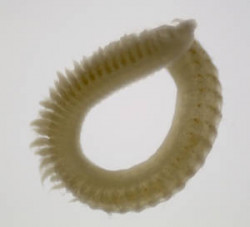
Latin name: Aricidea spp.
Scientific group or class: Polychaete
Description: Aricidea spp. are small paraonid worms, which are sub-surface deposit feeders and bioturbators. Aricidea spp. can be distinguished from other paraonids by a small thread-like antennae protruding from the top of the head.
Habitat: Prefer muddy sands and are sensitive to changes in mud content. Burrow to a depth of about 15cm.
Distribution: New Zealand wide
Indicator species: Yes
Why is this a good indicator species? Aricidea spp. tolerate a sediment mud content up to 70%, with an optimum range of 35-40%. Therefore, they are usually found in habitats that have a slightly greater proportion of sand than mud (e.g. muddy sands). Aricidea spp. have also shown sensitivity to lead and zinc contamination. Where estuarine sediments change from a sandy to muddier type habitat the abundance of Aricidea spp. is expected to increase. However, where sediments become more polluted (particularly with lead or zinc) and/or where sediment mud content exceeds their optimum range (35-40%), Aricidea spp. are expected to decrease in abundance. These responses to change in the physical and chemical environment make Aricidea spp. good indicators with which to assess changes in the input of sediment and pollutants into our estuaries.
-
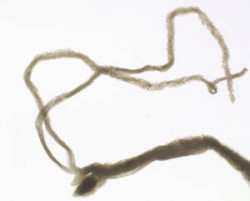
Latin name: Magelona dakini
Scientific group or class: Polychaete
Description: Magelona dakini is a small, thin and shovel-nosed (shield like head) burrower and subsurface deposit feeder. Adults grow up to 70mm long. These worms are visible to the naked eye as pinkish threads when sediment clumps are broken apart by hand.
Habitat: Magelonids build meandering burrows (usually below the top 20mm of sediment) in medium to fine sands. They occur over a range of depths from mid-intertidal and subtidal to the continental slope.
Distribution: New Zealand wide
Indicator species: Yes
Why is this a good indicator species? At present the tolerance of magelonids to sediment mud content is unknown. However, they are usually most abundant in sandy habitats. Magelonids are highly sensitive to lead contamination. Where estuarine sediments become polluted (particularly with lead) and/or very muddy, the abundance of magelonids is expected to decline. This makes magelonids a good indicator species with which to assess changes in the input of pollutants and fine sediment into our estuaries.
-
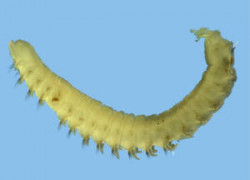
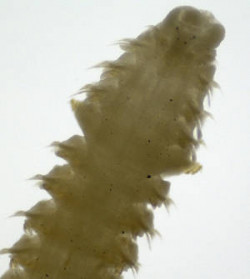
Latin name: Pseudopolydora complex (often termed ′polydorids')
Scientific group or class: Polychaete
Description: Polydorids are tube-dwelling worms, with tubes that are made of fine grains and are flexible. They are surface deposit-feeders, which can switch to suspension feeding. They can form dense mats which help stabilise the sediment surface, and therefore play an important role in maintaining community structure. Some species specialise in boring into shells.
Habitat: They live in a wide range of habitats from fine sand to sandy mud.
Distribution: New Zealand wide
Indicator species: Yes
Why is this a good indicator species? Most polydorids live in sediments ranging from fine sand to sandy mud, while some are tolerant of muddier sediment (15-30%). Polydorids have also shown sensitivity to lead contamination. Where estuarine sediments becomes muddier and/or polluted (particularly with lead), the abundance of polydorids is likely to decline. This makes polydorids a good indicator to assess changes to the input of sediment and pollutants into our estuaries.
-
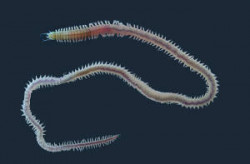
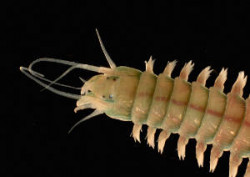
Common name: Ragworms
Latin name: Nereididae
Scientific group or class: Polychaete
Description: Nereidids are large thick worms, usually green or brown in colour, with two pairs of large eyes. They are active omnivores. Adults can grow to more than 300mm long and 20mm thick, although most adult nereidids are about 50-100mm in length, and some are much smaller.
Habitat: Prefer muddy sand to mud habitats in areas of reduced salinity
Distribution: New Zealand wide
Indicator species: Yes
Why is this a good indicator species? Nereidids tolerate a sediment mud content of up to 100%, with an optimum range of 35-60%. Therefore, they are usually most abundant in moderately to very muddy habitats. Where estuarine sediments change from a sandy to muddier type habitat the abundance of nereidids is expected to increase. However, where sediment mud content exceeds their optimum range (>60%),nereidids are expected to decrease in abundance. Nereidids are not sensitive to copper, lead and zinc contamination and can be found in high densities in relatively contaminated sediments. Their abundance often increases in contaminated sediments. It is not known if this represents a preference for contaminated sediments or results from a contamination intolerance of their competitor species. These responses to change in the physical and chemical environment make nereidids a good indicator species with which to assess changes in the input of sediment and pollutants into our estuaries.
-
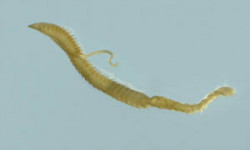
Latin name: Cossura consimilis
Scientific group or class: Polychaete
Description: Cossura consimilis is a slender thread-like worm with a blunt head. It is a small deposit feeder, growing up to 20mm in length.
Habitat: They live in muddy sand in depths ranging from shallow intertidal harbours and estuaries to the inner continental shelf and out to the continental slope (0-2000m).
Distribution: New Zealand wide
Indicator species: Yes
Why is this a good indicator species? Cossura consimilis tolerates a sediment mud content of 5 to 65%, with an optimum range of 20-25%. Therefore, it is usually found in habitats which are more sandy than muddy (e.g. muddy sand). Cossura consimilis has also shown sensitivity to copper contamination. Where estuarine sediments become muddier (exceeding their optimum range) and/or polluted (particularly with copper), the abundance of Cossura consimilis is likely to decline. This makes Cossura consimilis a good indicator species with which to assess changes in the input of sediment and pollutants into our estuaries.
-
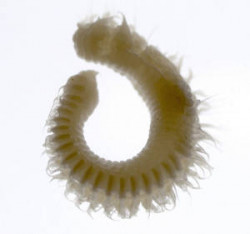
Latin name: Orbinia papillosa
Scientific group or class: Polychaete
Description: Orbinia papillosa is a large sub-surface deposit feeder and bioturbator. It has a small pointed head without eyes. Adults can grow in size to more than 100mm long but are less than 2mm in width. Orbinia papillosa is prey for fish and birds.
Habitat: Lives throughout the sediment preferring sandy habitats
Distribution: New Zealand wide
Indicator species: Yes
Why is this a good indicator species? Orbinia papillosa tolerates a sediment mud content up to 40%, with an optimum range of 5-10%. Therefore, it is usually found in sandy habitats. Orbinia papillosa has been shown to be slightly sensitive to zinc contamination. Where estuarine sediments becomes muddier (exceeding the optimum range) and/or polluted (particularly with zinc), the abundance of Orbinia papillosa is likely to decline. This makes Orbinia papillosa a good indicator species with which to assess changes to the input of sediment and pollutants into our estuaries.
-
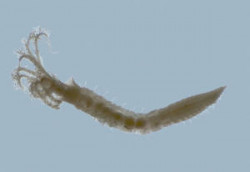
Common name: Fan or feather-duster worms
Latin name: Euchone spp.
Scientific group or class: Polychaete
Description: Euchone spp. are small (<20mm length) sabellid or fan worms (named from the fan-like feeding appendages). They are suspension-feeders and are often found encased in a sandy tube, protruding above the sediment surface with the fan-like tentacles exposed.
Habitat: Soft sediment habitats
Distribution: New Zealand wide
Indicator species: Yes
Why is this a good indicator species? At present, the tolerance of Euchone spp. to sediment mud content is unknown. Euchone spp. are known to be sensitive to copper and zinc contamination. Where estuarine sediments becomes polluted (particularly with copper or zinc), the abundance of Euchone spp. is expected to decline. This makes Euchone spp. good indicators with which to assess changes in the input of pollutants into our estuaries.
-
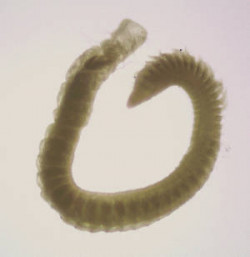
Latin name: Paraonidae (paraonids)
Scientific group or class: Polychaete
Description: Paraonidae is a family of thin slender burrowing worms. Paraonids are mainly subsurface deposit feeders. Adults can grow in size to 40mm in length and a width of 1mm but are usually much smaller.
Habitat: Prefer living in muddy sands over a range of habitats from intertidal flats in estuaries and harbours to the deep sea.
Distribution: New Zealand wide
Indicator species: Yes
Why is this a good indicator species? At present the tolerance to sediment mud content and optimum range for paranoids is unknown. However, they generally prefer habitats with some mud (muddy sands) and some paranoids (Aricidea spp.) are known to tolerate mud content up to 70% with an optimum range of 35-40%. Therefore, where estuarine sediments change from a sandy to muddier type habitat the abundance of paranoids is expected to increase. However, where the sediment mud content becomes very high, paraonids are expected to decrease in abundance. For this reason, paranoids are good indicators for assessing change of sediment input to our estuaries.


To ask for help or report a problem, contact us
Tell us how we can improve the information on this page. (optional)